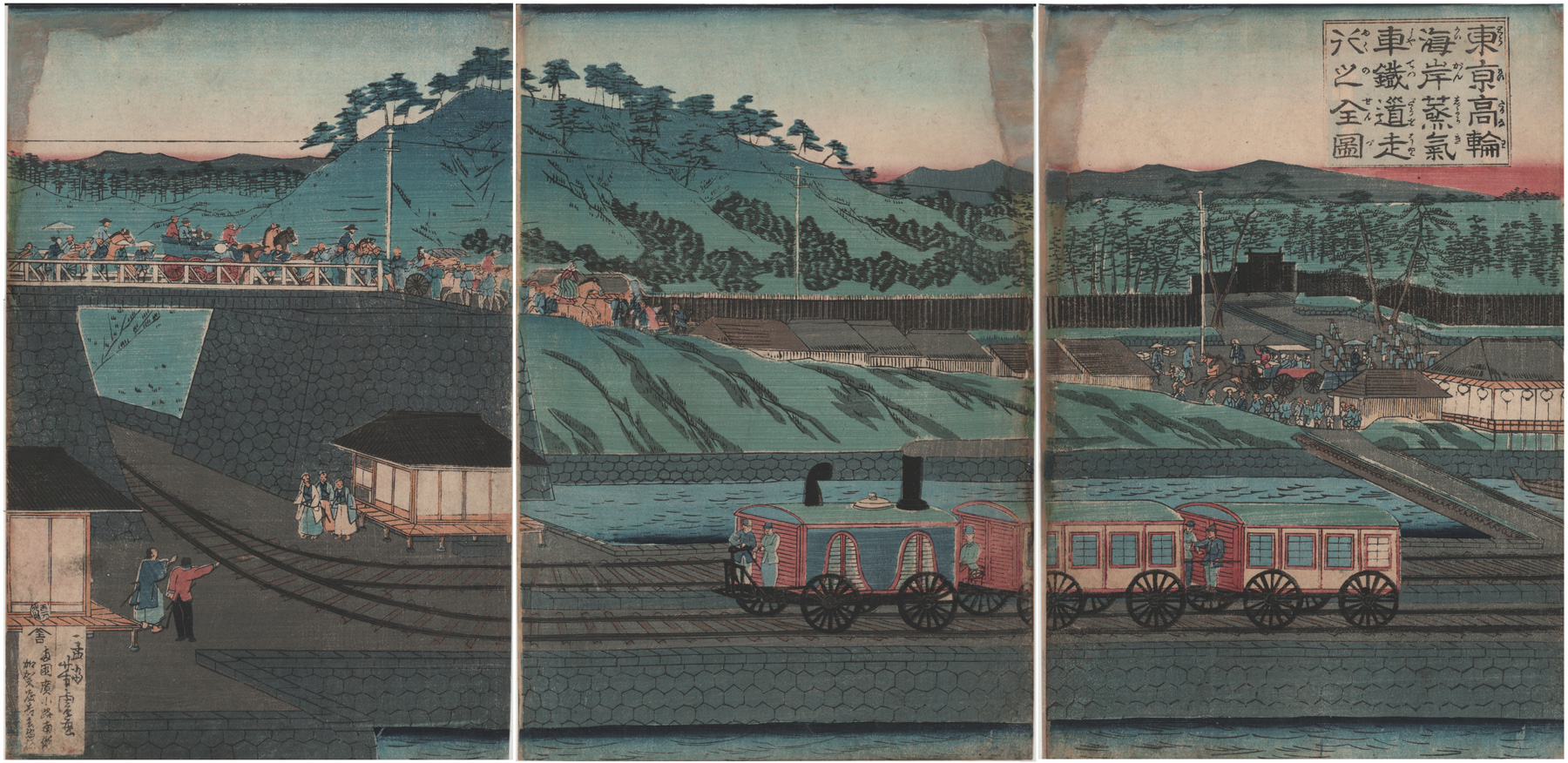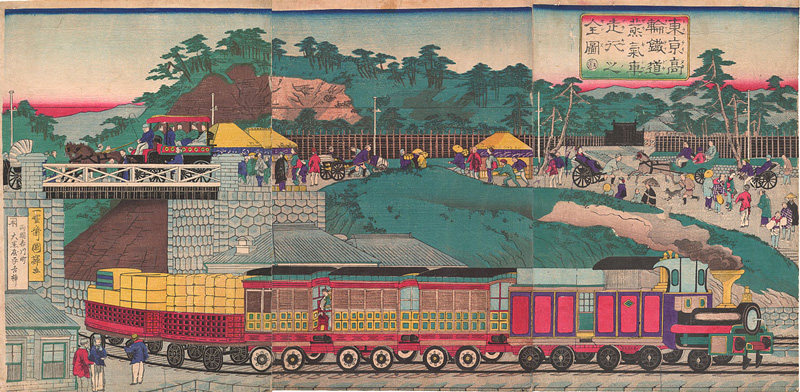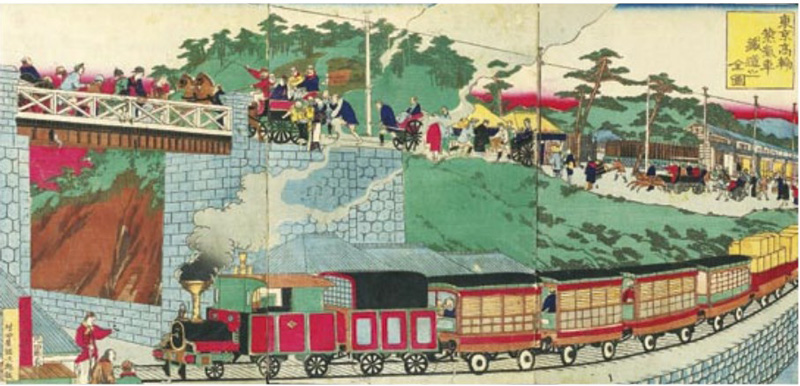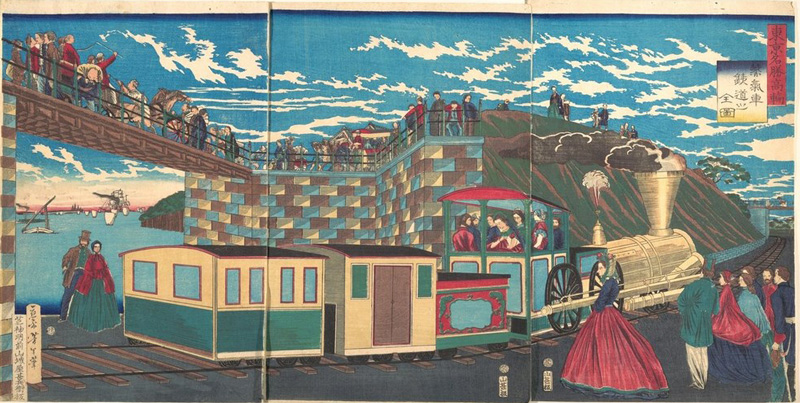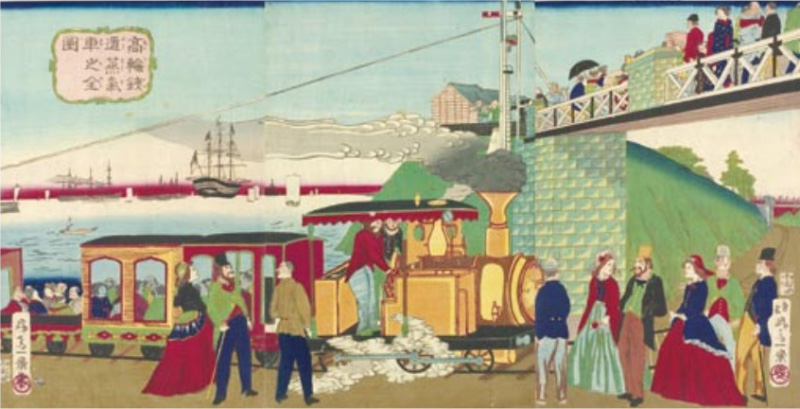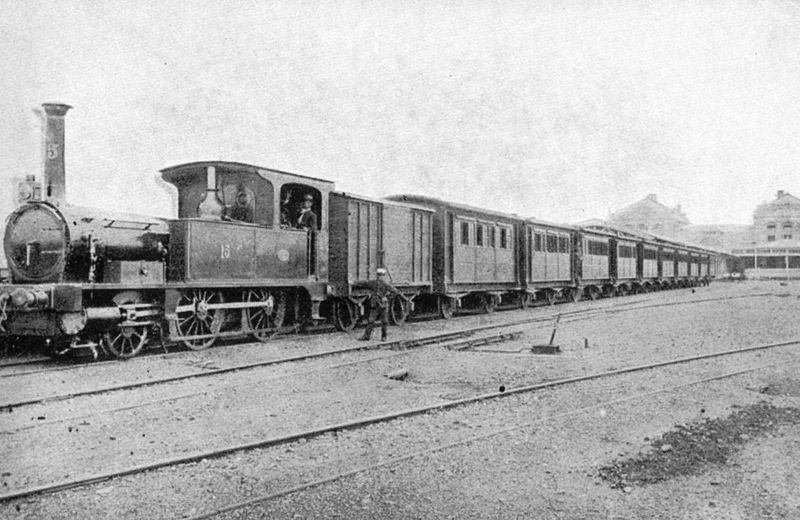About This Print
The little steam train from Shinagawa in Tokyo to Yokohama started running in the summer of 1872. This print, however, was issued sometime in 1871 and was likely based on the artist's imagination of a steam train, culled from American and/or European illustrations. Plans for the rail line between Yokohama and Tokyo were announced in 1870 and it immediately became "an emblem of civilization and enlightenment [bumei kaika]."1 Publishers rushed to represent this modern conveyance and dozens of prints ensued, several of which are shown below, including two by the artist Utagawa Kuniteru II (1830-1874) which present an almost identical view as in this collection's print, but with a slightly more sophisticated looking train.
For another view of an early steam train see Tokyo meisho Shimbashi Stenshon by Utagawa Hiroshige III (1842–1894).
Similar Prints by Kuniteru II
Kuniteru's picture of a train passing under the bridge at Takanawa just beyond the southern limits of the city is dated to the equivalent of March 1870 [when the plan for the railway was first announced], and is thought to be based on a British model illustrated in a Western book.... The cluster of buildings to either side of the track must represent Shinagawa Station, which did not in fact open for business until June 1872.
Traffic on the overhead highway (the Tōkaidō) includes... rickshaws, two types of horse-drawn carriages, and assorted handcarts. Telegraph wires, yet another example of the latest in imported technology, are conspicuous along the highway.2
1 The World of the Meiji Print: Impressions of a New Civilization, Julia Meech-Pekarik, Weatherhill, 1986
Yokohama Prints from Nineteenth-Century Japan, Yonemura, Smithsonian Institution, 1990, p. 85-86.2 Ibid., p. 84
Other Prints of the New Rail Line and Steam Train at Takanawa
Tsukioka Yoshitoshi (1839-1892)
Scenic Spots in Tokyo: Steam Locomotive Train Tracks at Takanawa
September/October 1871
Tōkyō meishō Takanawa-jōki kikansha no zen zu
Shōsai Ikkei (fl. c. 1870s)
A Steam Engine on the Railroad at Takanawa, 1872
Takanawa tetsudô jôkisha no zenzu
Photograph of Steam Train at Shimbashi Station ca. 1872
A Young Man's Reminiscences
Source: Literary Life in Tōkyō, 1885-1915: Tayama Katai's Memoirs'Thirty years in Tōkyō,' Katai Tayama and Kenneth G Henshall, Brill, 1987, p. 46.
The wonder of the new rail line, even more than ten years after its commissioning, is captured by the writer and poet Tayama Katai (1872-1930) as he reminisced about his experiences as a young errand boy in the early 1880s and his occasional trips to Takanawa.
When I went to Takanawa I used to enjoy looking at the sea and the steam train going along the coast. Having been brought up in the countryside I found such things fascinating. I’d gaze entranced at the sailboats and steamboats as they passed by under big white clouds that hovered like birds’ wings. I’d be enchanted by the sight of the little steam train threading its way along the coast from the direction of Shinagawa, spilling out its grimy smoke. In those days there was only one railway line in Japan, and that was between Tokyo and Yokohama. And there were songs in fashion like the one that went:
The train’s setting off – sai, sai,
Leaving its smoke – sai, sai:
Isn’t it horrid, all this smoke! – sai, sai.
The train was still a novelty even for city dwellers. It was around this time [summer of 1885] that the Frenchman Pierre Loti came to Japan, and he really insulted the Tokyo-Yokohama train – or rather, looked upon it with pity – and said, “A train, in Japan! A tiny little train! A rickety-rackety, bone-jarring little train!” But nevertheless, pathetic little train that it was, it did represent the first major enterprise of the Japanese government. I used to stand about twenty yards back from it, as though it were some sort of monster, and stare as it went on its way surrounded by smoke and noise.
Print Details
| IHL Catalog | #1175 |
| Title or Description | Steam Train at Takanawa Seashore, Tokyo 東京高輪海岸蒸気車鉄道走行之全図 とうきょうたかなわかいがんじょうきしゃてつどうをはしりゆくのぜんず Tōkyō Takanawa kaigan jōkisha tetsudō hashiriyuki no sen zu |
| Artist | Utagawa Yoshitora (fl. c. 1836-1882) |
| Signature |  |
| Seal |  |
| Publication Date |  1871 (year of the goat) 未二改 吉一刀 |
| Publisher | Kichi seal - possibly the seal of Kagaya Kichibei 加賀屋吉兵衛 who published many of Yoshitora's prints. This seal is not shown in Marks. |
| Impression | excellent |
| Colors | good |
| Condition | poor - water stains; paper rubbed; backed; separate sheets |
| Genre | ukiyo-e; kaika-e |
| Miscellaneous | |
| Format | vertical oban triptych |
| H x W Paper | (L)13 15/16 x 9 1/4 in. (35.4 x 23.5 cm); (C) 13 15/16 x 9 7/16 in. (35.4 x 24 cm); (R) 14 x 9 1/2 in. (35.6 x 24.1 cm) |
| Literature | |
| Collections This Print | The Tsubouchi Memorial Theatre Museum of Waseda University 201-3873, 201-3874, 201-3875; Library of Congress FP 2 - Chadbourne, no. 178 a, b, c (A size) [P&P] |


